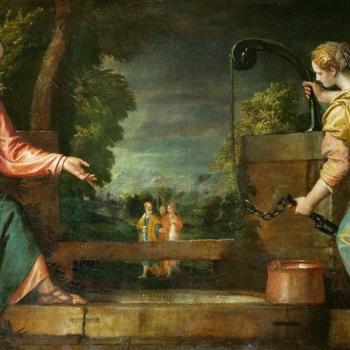Is religion like the Pit of Despair, sucking life from you? The good news is you’re only mostly dead. And mostly dead is slightly alive.

The Princess Bride is one of my favorite movies. In the film, the rogue Inigo Montoya (Mandy Patinkin) asks Miracle Max (Billy Crystal) for a resurrection-cure for his slain friend, Westley (Cary Elwes), Aka Dread Pirate Roberts.
Miracle Max : He probably owes you money huh? I’ll ask him.
Inigo Montoya : He’s dead. He can’t talk.
Miracle Max : Whoo-hoo-hoo, look who knows so much. It just so happens that your friend here is only MOSTLY dead. There’s a big difference between mostly dead and all dead. Mostly dead is slightly alive. With all dead, well, with all dead there’s usually only one thing you can do.
Inigo Montoya : What’s that?
Miracle Max : Go through his clothes and look for loose change.
In the Pit of Despair
Westley had been through a lot. Count Rugen hit him over the head, dragged him into the Pit of Despair, and used a torture machine to suck the life out of him. Sometimes that feels like an accurate description of some things that I’ve been through. Does that resonate with you, too? Maybe you’ve had your life and faith sucked right out of you, and the only thing left to do is go through your clothes and look for loose change.
Asking for a Miracle
Lots of things can kill a person’s faith. Sometimes religious death is caused by the world hitting you over the head too much. Or you witness others in the Pit of Despair. You pray and pray for them, but never see them rescued. Or maybe you’ve longed for deep spirituality but found that the doctrines you grew up with no longer make sense. You feel that those messed-up teachings have sucked the life right out of your faith. You’ve told your friends about your doubts, questions, and concerns. They’re wondering how this could have happened and are asking for a miracle.
Maybe you want a miracle, too. You want your faith to be saved. Or maybe you don’t. Perhaps you’ve been through so much that you’re just done. The good news is that no matter how dead you feel you are, you’re not all dead. You’re only mostly dead. And mostly dead is slightly alive.
Don’t Rush a Miracle
In the Gospel of John, Mary and Martha sent Jesus a message, begging him to come quickly and heal their dying brother. But as Miracle Max said, “You rush a miracle, man, you get rotten miracles.” It took Jesus until Lazarus had been in the grave four days before he and his disciples showed up. What follows may be an account of a dead (or mostly dead) man brought back to life, but for our purpose, it serves as an allegory for what Jesus can do with a dead faith.
When Jesus arrives, Mary and Martha show the ambivalence that comes with shattered faith. First, they blame him for Lazarus’ death, saying, “If you had been here, our brother would not have died.” Yet, Martha also says, “But I know that even now God will give you whatever you ask.” In the same way, people who are deconstructing their faith—and those who have abandoned it altogether—still at times find themselves grasping at hope. There’s something inside that wants to believe, even when belief is difficult.
Jesus Wept
The shortest verse in the Bible (John 11:35) says that “Jesus wept.” This may have been for his own grief, or out of empathy for their loss. Yet, he knew what he was about to do, and he knew that Lazarus would return. So it seems more likely that he wept when he heard the ambivalent words of Mary and Martha, grasping for faith but blaming God at the same time. If you feel your faith is dead, I want you to know that God feels your pain. God can take all the blame you want to dish out. It’s natural for you to vacillate between fear and faith, acceptance, and rejection.
Jesus weeps because he knows how you’re feeling. At one time, Jesus felt forsaken by God, just like you. And because he’s felt it, he can understand it. Jesus loved the family of Mary, Martha, and Lazarus when they were full of faith, but he loved them when they struggled to believe as well. Just because your faith feels dead, that doesn’t mean God has left you. God weeps when you weep and will walk with you as you grieve the hope you’ve lost.
Mostly Dead is Slightly Alive
Next, Jesus reminds us that there’s no such thing as all dead, anyway. Lazarus, just like your faith, isn’t gone. He’s only mostly dead. And mostly dead is slightly alive. “I am the resurrection and the life,” Jesus says. “The one who believes in me will live, even though they die; and whoever lives by believing in me will never die.”
For just a minute, I want you to quit thinking of eternal life as going to heaven when you die. That’s such a small part of what this phrase means. Jesus said, “I have come that they may have life, and that they may have it more abundantly (John 10:10).” If you’re having a tough time with concepts like doctrinal statements about the afterlife, forget them. Focus on breathing—simple breathing.
Living an abundant life today. That’s all Jesus asked Lazarus to do. And that’s all he wants from you. To put your hand in his and be alive. If you can say yes to that, there is a reconstruction after your deconstruction. There’s a resurrection of faith after its demise.
Be Honest About What’s Inside the Grave
Jesus said, “Take away the stone,” but Martha told him, “Lord, by this time there is a bad odor, for he has been in there four days.” Jesus knew that to come alive, you’ve got to open up all the pain that caused your faith to die. You’ve go to smell the corruption in the church that disillusioned you. Face the darkness of your damage. Take a good look at the rotten dogmas that you can no longer believe. Be honest about what’s inside the grave.
Only when you open up the tomb and face death can you step into the light. For you, opening this tomb may involve going to counseling to dig deeper into your sense of loss. It might mean taking out a pen and paper and writing down everything that you no longer believe—and following up with journaling about what remains. The grave of religion is a scary place, but if you’re willing to open it up and smell the stench, you’ll be able to step out of it and into an open breathing space.
You Just Wiggled Your Finger—That’s Wonderful!
When Lazarus stepped out of the grave, he didn’t emerge the same as he had been before. And neither will you. If your faith is revived, it’s going to look different. And it will take time. “Remove his grave clothes and let him go,” Jesus said, reminding us that his friend wasn’t raised in a vacuum. Lazarus emerged into a community that would help him peel off the layers of death so he could live again. Coming to life doesn’t happen for you all at once. It happens bit by bit. Your friends may have to take off your grave clothes, carry you around awhile, stand you up, and lie you down like Inigo and Fezzik did for Westley. Pretty soon your friends will say, “You just wiggled your finger–that’s wonderful!” They’ll help you limp along, and pretty soon, you’ll be storming the castle.
The Life That Really Is Life
I don’t want to paint a rosy picture of what it’s like when someone loses their faith. The grief, trauma, isolation, fear, and heartbreak are real. I do want to encourage you, that whether you ever call yourself a Christian again or not, there is life after this religious death. Because God is bigger than the labels we grew up with—and bigger than the doctrines we throw away. If religion has felt like a cold, dark tomb, I pray that you’ll listen to the voice that calls you out of the grave. And in the end, I hope you’ll leave a trail of wrappings behind, so you can walk into the life that really is life.
For related reading, check out my other articles:
- No, Jesus’ Death Was Not Your Fault
- When Jesus Talked About Deconstruction
- What If The Church Valued Doubt As Much As Faith?














